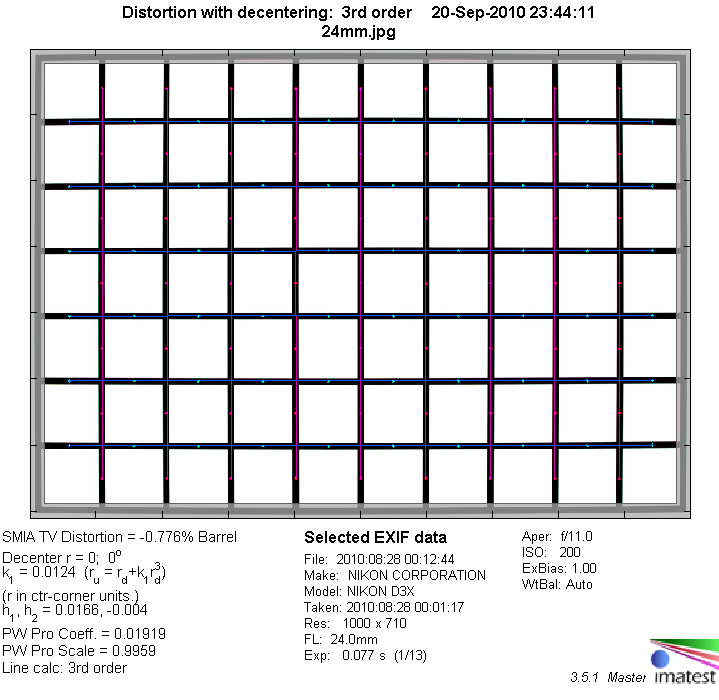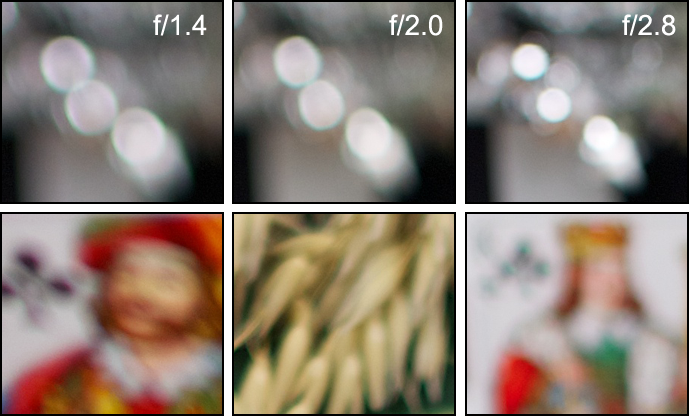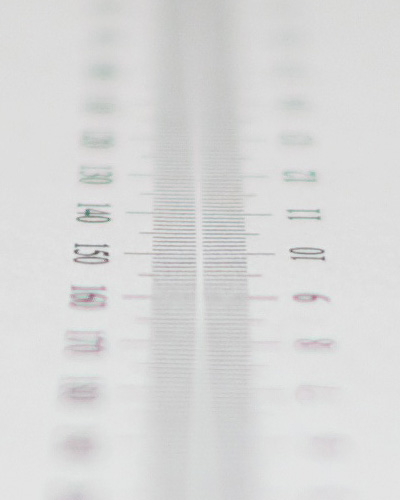|
Page 2 of 2

Distortion
The lens shows a very moderate amount of barrel distortion. Unless for really critical subjects like architecture or similar subjects with straight lines close to the image border, distortion is not an issue in the field.

The chart above has a real-world size of about 120x80cm.
Vignetting
Fast lenses tend to suffer from high vignetting, on the other hand FX lenses used on DX cameras can often take advantage of their large image circle, where the critical outer parts are cropped. This is certainly true for the AF-S 24. With almost around 0.7 EV wide open the amount of vignetting is visible in the final image, but low enough to not be an issue for most subjects. As usual, stopping down helps to reduce vignetting, from f/2 onwards it's no longer field-relevant.

MTF (resolution)
In our lab tests the AF-S 24 produced very good results for a lens in this class. The center resolution is excellent straight from the maximum aperture. The borders follow one step behind, with very good resolution wide open and excellent sharpness stopped down to f/4 and beyond (until diffraction limits the resolution, of course).
Typical for such lenses the corners however are somewhat soft wide open. Stopping down to f/4 increases the resolution to very good figures, though.
The lens showed some focus shift when stopping down (residual spherical aberration).
Please note that the MTF results are not directly comparable across the different systems!
Below is a simplified summary of the formal findings. The chart shows line widths per picture height (LW/PH) which can be taken as a measure for sharpness.
If you want to know more about the MTF50 figures you may check out the corresponding Imatest Explanations

Chromatic Aberrations (CAs)
Chromatic aberrations (color shadows at harsh contrast transitions) are in the range of 1 to around 1.3 pixels on the average at the image borders. This might be visible in very large prints (or crops). However, for typical print sizes the problem isn't really field-relevant for most subjects. In addition, CAs can easily be corrected in software or by the camera itself (most modern Nikon DSLRs remove CAs if you shoot JPGs).

Bokeh
One of the primary usage scenarios for a large aperture lens is to seperate the main subject from the background. In such an image the quality of the bokeh (out-of-focus blur) is of major significance.
Bad news first - the bokeh in front of the focal plane can be somewhat nervous. However, for a wide angle lens, this is hardly a field-relevant issue. Behind the focal plane, the lens produces very smooth and pleasant blur, including the transistion zones.
Thanks to 9 rounded aperture blades, background highlights retain their circular shape throughout the whole aperture range. Highlights are evenly filled, there is almost no outlining, but some traces of LoCAs (which are typical for this lens glass, see next section). For a wide angle lens, this is a very impressive performance.

Bokeh Fringing / Longitudinal Chromatic Aberrations (LoCA)
LoCAs (non-coinciding focal planes of the various colors) are a common issue with relatively fast glass. As you can
notice below the halos have different colors - magenta (red + blue) in front of the focus point
and green beyond. Truly "apochromatic" lenses don't show LoCAs but these lenses are very rare especially
below 100mm. Unlike lateral lateral CAs, LoCAs cannot easily be fixed in post processing.
Typical for most fast primes, especially ultra fast ones, the AF-S 24 shows some amount of LoCAs at large aperture settings, which can of course be reduced by stopping down.
In addition, these shots also show the focus shift when stopping down.
|
Move the mouse cursor over the f-stop marks below to observe the respective LoCAs
|
| f/1.4 |
f/2 |
f/2.8 |
f/4 |
f/5.6 |
|

|
Sample Shots
Full size sample images are available in our FX review of this lens.
VerdictThe Nikkor AF-S 24 f/1.4 is an impressive lens. At large apertures it produces very sharp images in the image center with somewhat soft corners wide open, but stopped down it shows very good to excellent sharpness across the whole (DX) frame. Distortion is very low and CAs are moderate. LoCAs are present at larger apertures but this is typical for such a fast prime. Vignetting is well under control for such a fast lens. The bokeh is very smooth and actually pretty much outstanding for a wide angle lens.
The build quality is on a very high level including sealing against dust and moisture.
One feature not mentioned yet is the lens' ability to focus rather close (0.25m) which, combined with the wide angle of view and large aperture, can lead to very interesting perspectives and unique results.
So in summary it's a very fine piece of glass. A somewhat specialized and certainly pricey tool though.
One final note: there have been user reports of AF issues with this lens. We had no such issues with the tested sample.
|